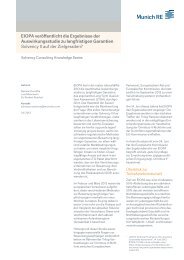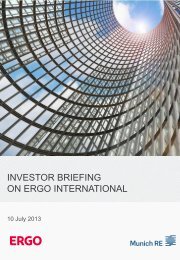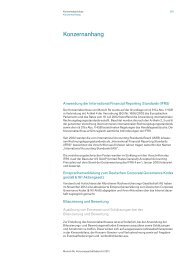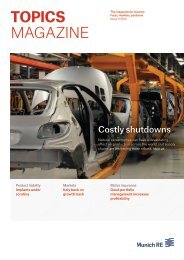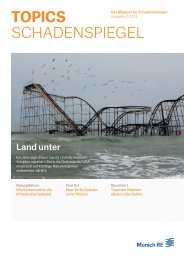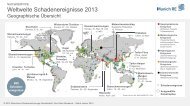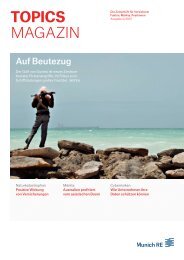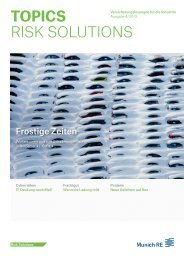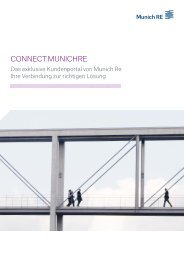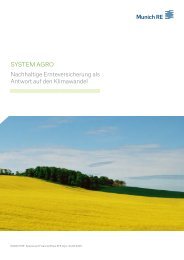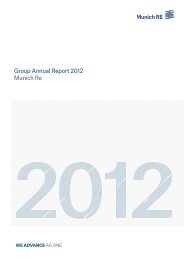Munich Re Group Annual Report 2006 (PDF, 1.8
Munich Re Group Annual Report 2006 (PDF, 1.8
Munich Re Group Annual Report 2006 (PDF, 1.8
You also want an ePaper? Increase the reach of your titles
YUMPU automatically turns print PDFs into web optimized ePapers that Google loves.
<strong>Munich</strong> <strong>Re</strong> <strong>Group</strong> <strong>Annual</strong> <strong>Re</strong>port <strong>2006</strong> Management report_<strong>Munich</strong> <strong>Re</strong> <strong>Group</strong><br />
<strong>Munich</strong> <strong>Re</strong> <strong>Group</strong><br />
Structure of the <strong>Munich</strong> <strong>Re</strong> <strong>Group</strong><br />
The <strong>Munich</strong> <strong>Re</strong> <strong>Group</strong> is one of the world’s leading risk<br />
carriers. Our business covers the whole value-added chain<br />
in insurance and reinsurance, and we are also active in the<br />
field of asset management.<br />
The reinsurance companies in our <strong>Group</strong> operate globally.<br />
Our primary insurers traditionally concentrate on<br />
Germany and European markets with strong growth, but<br />
are now looking to extend their activities to high-potential<br />
markets such as India. We conduct our business from our<br />
respective headquarters and also via a large number of<br />
branches, subsidiaries and affiliated companies in such<br />
countries as the USA, China, India, Australia, South Africa,<br />
Korea, Canada, the UK, France, Spain, Italy, Poland and<br />
Switzerland. Control and profit transfer agreements are in<br />
place with many subsidiaries, especially those in the ERGO<br />
Insurance <strong>Group</strong>. As a result of a <strong>Group</strong> directive of 2005<br />
governing the distribution of responsibilities and competencies<br />
between <strong>Group</strong> management and ERGO for key<br />
decisions, there is “unified control” within the meaning of<br />
the German Stock Companies Act.<br />
With a view to maintaining clearly defined strategic<br />
management of the equal-ranking business segments of<br />
primary insurance and reinsurance – and to providing for<br />
a clear assignment of responsibility – the structure of<br />
<strong>Munich</strong> <strong>Re</strong>’s Board of Management was altered with effect<br />
from 1 January <strong>2006</strong>. The Parent Board of Management,<br />
which for legal purposes continues to represent <strong>Munich</strong><br />
<strong>Re</strong>insurance Company externally, has divided its responsibilities<br />
between two Board committees: the <strong>Group</strong> Committee<br />
and the <strong>Re</strong>insurance Committee.<br />
This management report summarises the activities of<br />
our <strong>Group</strong> according to the business fields of reinsurance,<br />
primary insurance, asset management and their respective<br />
segments, rather than on the basis of the <strong>Group</strong>’s legal or<br />
corporate structure. Such segmentation is determined by<br />
how we manage our business internally.<br />
48<br />
<strong>Munich</strong> <strong>Re</strong> <strong>Group</strong><br />
<strong>Re</strong>insurance<br />
Asset management<br />
Primary insurance<br />
<strong>Re</strong>insurance group<br />
Of the gross premiums totalling €22.2bn written in <strong>2006</strong>,<br />
around 65.5% came from property-casualty and 34.5%<br />
from life and health business.<br />
According to our own estimates, <strong>Munich</strong> <strong>Re</strong>’s share of<br />
the world market in terms of <strong>2006</strong> premium amounted to<br />
around one-seventh. The market we refer to here is the<br />
global reinsurance market, since reinsurance has by nature<br />
always been an international business. It should be noted<br />
in this context, however, that the global premium income<br />
of the reinsurance markets is difficult to quantify because<br />
data is insufficient or simply not available, while the market<br />
statistics of individual countries are of limited comparability<br />
as they are based on different parameters. What is<br />
more, premium volume alone is not an adequate indicator<br />
for assessing reinsurance companies’ importance in<br />
particular markets.<br />
Since 1 January 2007, our reinsurance business has<br />
been organised into six operative divisions. Until 31 December<br />
<strong>2006</strong>, there were seven: six servicing our propertycasualty<br />
business and special lines, and one dealing with<br />
life and health reinsurance. <strong>Re</strong>sponsibility for the respective<br />
client accounts continues to lie in one pair of hands.<br />
The operative divisions are also responsible for our business<br />
units abroad, including our subsidiaries.<br />
The division Life and Health underwrites our life and<br />
health reinsurance business worldwide and its structure<br />
reflects that of many of our clients, which conduct these<br />
two classes of business separately from property-casualty<br />
insurance, often through independent entities.<br />
In Europe 1, we until recently managed the propertycasualty<br />
business from our clients in Germany, Switzerland<br />
and Austria, eastern Europe, Greece, and Turkey. With<br />
effect from 1 January 2007, the division has been divided<br />
and incorporated into the new units “Europe and Latin<br />
America” and “Germany, Asia Pacific and Africa”.



